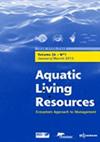缺口监测仪在平牡蛎摄食行为研究中的适用性
IF 1.9
4区 农林科学
Q3 FISHERIES
引用次数: 0
摘要
在平牡蛎礁恢复项目中,需要创新的技术来评估牡蛎的性能。阀门间隙监测仪是一种连续测量活双壳类开合的装置,它可能被用作确定欧洲扁平牡蛎(Ostrea edulis)存活和行为的有效方法。该方法已成功地与许多双壳类动物结合使用,研究了对环境因素的响应。在这项研究中,8只黄菖蒲配备了阀门间隙传感器,以便将间隙与环境条件(如食物供应)联系起来。在受控的实验室条件下,在Oosterschelde的混凝土盆地和现场(荷兰北海Voordelta),在有食物和没有食物的情况下监测阀口活动。在受控的实验室条件下,牡蛎对食物供应的变化有明显的反应。饥饿的牡蛎关闭阀门的时间明显长于进食的牡蛎,而进食的牡蛎的相对宽度更大。在混凝土盆地(Oosterschelde),阀门开度与叶绿素-a呈正相关。此外,阀口活动和潮汐运动似乎是有联系的。当暴露于一个完整的潮汐循环(Voordelta)时,阀开度与叶绿素-a呈负相关。然而,阀门间隙与流速之间没有相关性。在秋季,观察到较长时间的不活动,但当阀门打开时,阀门间隙更大。这些数据表明阀门间隙可以提供有价值的行为信息(间隙频率和间隙宽度),但也表明它不一定是喂料速率的良好代表。尽管如此,这些结果表明,裂口监测仪可以用于确定野外条件下平牡蛎的自然行为,并且裂口打开提供了双壳类动物对环境条件的行为和应激反应的信息。本文章由计算机程序翻译,如有差异,请以英文原文为准。
Applicability of the gape monitor to study flat oyster (Ostrea edulis) feeding behaviour
Innovative techniques are needed to assess oyster performance in flat oyster reef restoration projects. A valve gape monitor, a device that continuously measures opening and closing of live bivalves, can potentially be used as an effective method to determine survival and behaviour of the European flat oyster Ostrea edulis. The method has been successfully used in combination with a number of bivalve species to investigate valve gape activity in response to environmental factors. In this study, eight O. edulis were equipped with valve gape sensors in order to relate gape to environmental conditions such as food availability. Valve gape activity was monitored under controlled laboratory conditions, with and without food, in a concrete basin in the Oosterschelde and in the field (Voordelta, Dutch North Sea). Under controlled laboratory conditions, oysters clearly responded to changes in food availability. Starved oysters closed their valves significantly longer than oysters that received food, and the relative gape width in fed oysters was larger. In the concrete basin (Oosterschelde), a positive correlation between valve opening and Chlorophyll-a was found. Additionally, valve gape activity and tidal movement appeared to be linked. When exposed to a full tidal cycle (Voordelta), a negative correlation between valve opening and Chlorophyll-a was found. However, there was no correlation between valve gape and current velocity. In autumn, longer periods of inactivity were seen, but when valves opened, the valve gape was larger. These data indicate that valve gape can provide valuable information on behaviour (gape frequency and gape width), but also show that it is not necessarily a good proxy for feeding rate. Nevertheless, these results show that the gape monitor can be used to determine the natural behaviour of flat oysters under field conditions, and that gape opening provides information on behaviour and the stress response of bivalves to environmental conditions.
求助全文
通过发布文献求助,成功后即可免费获取论文全文。
去求助
来源期刊

Aquatic Living Resources
农林科学-海洋与淡水生物学
CiteScore
2.30
自引率
0.00%
发文量
10
审稿时长
>24 weeks
期刊介绍:
Aquatic Living Resources publishes original research papers, review articles and propective notes dealing with all exploited (i.e. fished or farmed) living resources in marine, brackish and freshwater environments.
Priority is given to ecosystem-based approaches to the study of fishery and aquaculture social-ecological systems, including biological, ecological, economic and social dimensions.
Research on the development of interdisciplinary methods and tools which can usefully support the design, implementation and evaluation of alternative management strategies for fisheries and/or aquaculture systems at different scales is particularly welcome by the journal. This includes the exploration of scenarios and strategies for the conservation of aquatic biodiversity and research relating to the development of integrated assessment approaches aimed at ensuring sustainable and high quality uses of aquatic living resources.
 求助内容:
求助内容: 应助结果提醒方式:
应助结果提醒方式:


